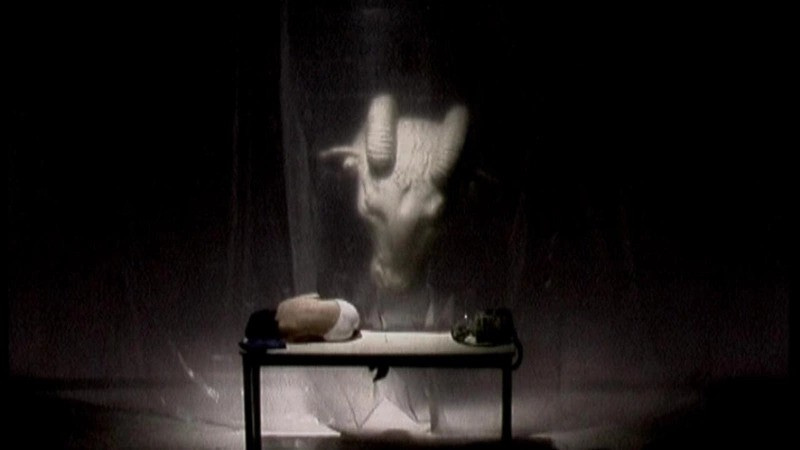TRAGEDIA ENDOGONIDIA, ROMEO CASTELLUCCI, AND SOCIETAS RAFFAELLO SANZIO
a short call towards a theater that comes after a dramatic theater
While I know it preceded the actual shelter-in-place, one of the things I know for a fact that I spent a lot of time doing during the first six months or so of the pandemic was reading everything possible related to Jerzy Grotowski. I have had more than a passing interest in theater and, more explicitly, performance art, for longer than I can remember, though I’ve never quite found myself satisfied with “theater” as one generally thinks of it.
Discovering the Viennese Actionists while in High School was a pivotal moment of articulation: of what art could do, of what one could do with the body as art. I mistook an interest in the performative capacity of the body for an interest in transgression itself, not realizing that the nuance of what pulled me in was how the two could interact: how can one put the body beyond that limit that it normally can be pushed to?
The answer (which I would ultimately spend the next twenty years investigating) was: through many routes. One of the routes, of course, was theater. Artaud was an inkling, but Artaud was more successfully a visionary than a theater maker. Many experimental filmmakers managed to do something that felt like what I wanted performance to do, but I most often mistook it for the capacity of the cinematographic medium (again, there’s an overlap; a direct push towards corporeality).
I first heard about Grotowski while investigating John Duncan. This alone offers a different entrance than most have. Even meeting academics linked to theater, when I’ve tried to strike up a conversation about Grotowski, they have of course heard of the man, but he doesn’t seem to exist beyond his Theater of Productions phase. “His” book, Towards a Poor Theatre (I put “his” in scare-quotes because a mere 1/10th or so of the book is actually the words of Grotowski). This was an essential phase, but what Grotowski moved onto, past theater, is infinitely more in line with what I was after.
But, let’s jump back in time. I’m not sure how it happened. Maybe it was through the early days of the Dennis Cooper blog, perhaps when Dennis was collaborating with Gisele Vienne. Who knows. But, somehow, Romeo Castellucci pops up on my radar. I watch a video of the performance Inferno and it does something, but I can’t remember what. The name stays on my radar. I spend years and years never digging deeper. A couple attempts that get thwarted. But.
Cut to: several months ago. I watch a documentary on Castellucci and the Societas Raffaelo Sanzio. An impulse download that I turn on over a rainy afternoon because of the runtime. I find, therein, exactly what it is that I’m looking for. I am changed. I am opened to something new. I understand something that I only “knew” as a reference before. This idea of post-dramatic theater… it becomes apparent. There is an idea. The prefix “post-” can sometimes be tedious, but sometimes it works like a transgression, it’s that moment that lets the medium move beyond.
There is a lot I am keeping absent here; I am talking around, instead of diving in. I think, in this case, this is intentional. It’s one thing to talk about the idea of an open door, it’s another thing to do the work to help someone else walk through it.
But.
There are other recordings. The earlier work has a sort of post-arte povera edge that, consistent with my perpetual aesthetics, I am most drawn to. No accessible recordings of the earlier work seem to be extant. But there is the rest of the trilogy based on Dante. Purgatorio, which does something with narrative, with the sort of arch nature of dramatic homelife, that again, pushes beyond. The idea of something so cliche that moves into something sublime. A transmission of empathy. Documentation of an installation, Paradiso: almost shocking in its congruency with past pivot points of reference. Gregor Schneider. Dieter Appelt. The body in extremis. Architecture as limit-text.
Finally, there is one more video. A video “adaptation” of a 11 part, multi-country theater work. I had tried before to watch this, but my attention would falter. Tragedia Endogonidia. I am weary of trying to describe what this “cycle” might or might not be about. It uses narrative in the same way that I do: as an opportunity for something beyond narrative. Sensation. Embodied experience, yeah, I use the term too much probably. But it’s ok. The Tragedia Endogonidia shows what theater can do. Almost like a catalog of ideas. It’s more than that. But this, to me, is what makes it important. There are so many more things that theater can do. And even via a secondary, mediated level of representation, so much can be done. A push towards something that so many of my favorite experimental films do via editing and processing. Light! The Body!
I want to leave this text here, not as anything conclusive. Maybe not even saying anything I want it to say. But, maybe, it will point to a door that you can open. There are “episodes” on YouTube. Type in some names. See what comes up. Click around. The title, Tragedia Endogonidia, can be a key if you let it. Maybe it won’t resonate right away. Maybe it will lodge in the background for years. Further down the line. Something might happen. Maybe you’ll just remember it as a reference. Someone will mention it. “Where have I heard that name before?”




